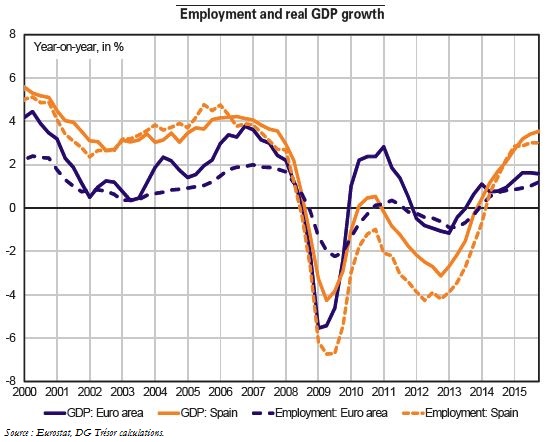Trésor-Economics No. 174 - Spain's labour market reform: an initial assessment
The economic crisis caused a steep rise in Spain's unemployment rate, from 8% in 2007 to a peak of over 26% in 2013. No other European Union (EU) country reached such levels of unemployment during the crisis except Greece, where the recession was three times as deep as in Spain.
Beyond the severe economic downturn, specific characteristics of the Spanish labour market may have helped to drive up unemployment during the crisis, as firms had limited scope for adjusting working conditions to the economic cycle. As a result, the adjustment was performed externally, causing the destruction of 3.3 million jobs, particularly fixed-term contracts.
Amid these developments, Spain adopted several major reforms of the labour market between 2010 and 2012 to increase firms' internal flexibility and reduce labour market segmentation by reversing the precedence of collective agreements (i.e., by granting priority to firm-level agreements), easing rules for terminating open-ended contracts and defining criteria for authorising layoffs for economic reasons. In 2010, an initial national inter-industry agreement sought to curb wage increases, and another agreement in 2012 gave even greater momentum to wage restraint.
Since end-2013, job creation seems vigorous thanks, in particular, to the economic rebound and very weak wage growth. Despite a decline in unemployment since end-2013, Spain still posts the EU's highest jobless rate after Greece, registering 20.9% at end-2015.
The impact of the labour market reforms on the new jobs is hard to assess given the lack of temporal perspective and the magnitude of the adjustments that hit the Spanish economy simultaneously. The implementation of certain measures remains limited since firm-level negotiations are still not a common practice. However, as the reform has given employers greater discretion in internal flexibility, they can carry out adjustments through hours worked, wages or work organisation rather than on employment. It will therefore be necessary to wait for the next cyclical turnaround to see if firms actually implement such adjustments, which preserve jobs.
Despite its sustained decline, unemployment remains high. The risk is that hysteresis effects can cause a lasting increase in structural unemployment, while skills requirements and difficulties in labour market matching may slow the decrease in unemployment.
